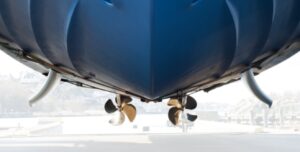Fin Stabilisers for Boats: Navigating Smooth Seas in a World of Waves
Overview

In the realm of maritime engineering, the quest for stability on the open sea has led to numerous innovations. One such groundbreaking solution is the integration of fin stabilisers into boats, a technology that has revolutionised the way vessels handle the challenges of rolling waves. In this article, we will explore the world of fin stabilisers, examining how they work, their benefits, and the impact they have on enhancing the overall seafaring experience.
Understanding Fin Stabilisers:
Fin stabilisers are retractable or fixed appendages attached to the hull of a boat, positioned below the waterline. These fins, typically made of high-strength materials such as stainless steel or composite alloys, play a pivotal role in countering the rolling motion of the boat. By adjusting the angle of the fins, boat operators can minimise rolling, providing a more stable and comfortable ride for passengers and crew, especially in rough seas.
How Fin Stabilisers Work:
When a boat encounters rolling motion due to waves or other environmental factors, the fin stabilisers come into action. As the boat rolls, the fins generate hydrodynamic lift, creating a force that opposes the rolling motion. By producing a counteracting force, the fins effectively reduce the boat’s side-to-side movement, stabilising the vessel and ensuring a smoother ride. The fins can be adjusted in real-time, allowing for precise control and adaptation to varying sea conditions.
Benefits of Fin Stabilisers:
- Enhanced Comfort: One of the primary advantages of fin stabilisers is the significant improvement in onboard comfort. By minimising rolling, these stabilisers mitigate seasickness and create a more pleasant experience for passengers and crew.
- Increased Safety: Stabilised boats are inherently safer, reducing the risk of accidents and injuries caused by excessive rolling. This enhanced stability ensures a more secure environment for both people and cargo onboard.
- Improved Fuel Efficiency: Fin stabilisers contribute to fuel efficiency by allowing vessels to maintain higher speeds even in rough seas. This improved performance can lead to considerable fuel savings, especially for larger vessels with high fuel consumption rates.
- Versatility: Fin stabilisers are versatile and can be installed on various types of boats, from luxury yachts and cruise ships to commercial ferries and naval vessels. Their adaptability makes them a valuable solution for different segments of the maritime industry.
- Ease of Operation: Modern fin stabiliser systems are designed with user-friendly interfaces, making them easy to operate and integrate into a boat’s existing control systems. This ease of operation ensures a seamless experience for boat operators.
Impact on the Boating Industry:
The integration of fin stabilisers into boats has had a profound impact on the boating industry. Luxury yacht owners now demand these stabilisers as a standard feature, enhancing the exclusivity and comfort of their vessels. Cruise lines have also embraced fin stabilisers, ensuring that passengers can enjoy smooth sailing even in the midst of challenging sea conditions. Furthermore, commercial operators and naval forces rely on fin stabilisers to guarantee stability during critical operations, further underscoring their importance in the maritime sector.
Conclusion:
Fin stabilisers have emerged as a vital technology in the maritime world, transforming the way boats navigate the unpredictable waters of the open sea. Their ability to enhance stability, comfort, and safety has made them an indispensable asset for boat owners and operators across the globe. As technology continues to advance, fin stabilisers are likely to play an even more significant role, ensuring that seafaring adventures remain smooth and enjoyable, regardless of the waves that come their way.


We at BMG Power Systems are working with Sleipner and Humphree fin stabilisers and thereby have a number of options to improve your ride. Hydraulic of electric fins? No problems! Curved Vector Fins by Sleipner or flat Humphree fins? Or fins combined with interceptors by Humphree? We have it all!



